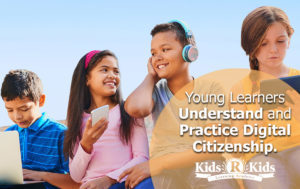We are enrolling! Join us in nurturing young minds, fostering creativity, and creating a brighter future. We're excited to introduce your child to a world of possibilities! Contact us today for details.
In the age of modern technology, it’s important that young learners understand and practice digital citizenship. But what is digital citizenship? Put simply, digital citizenship is the set of behaviors and standards that a person practices while utilizing technology. Just like we teach our children how to behave responsibly and respectfully in public spaces, the idea is the same on the internet. Here are some basic guidelines to teach your child on how to be a good digital citizen:

- Practice safety. It is important that while your child uses technology and interacts with the world through the internet, that he is aware of his own safety in these spaces. This includes sharing personal information, interacting with others online, and navigating websites, apps, etc. that are safe and appropriate for his age.
- Practice consent. Especially in the age of photo sharing on social media, it’s important that your child understands that when his photo or information is posted on the internet it is now accessible to the public. Understanding and giving consent to sharing photos of himself or others is important. Ask your child before posting a photo of himself and teach your child that before he shares or posts a photo of others to ask for consent himself.
- Practice critical thinking. In a world where information is quickly and easily spread, it is unfortunately often that certain information that is spread is false. Teaching your child to critically discern what information is false and what is real is critical. Teach him about fact checking, cross-examining ideas with other sources himself, and asking critical questions when presented with an idea to determine for himself is something is real or not.
- Practice digital literacy. This includes how and when to use technology, how to create and use media, information and ideas through technology, and what digital resources to use to promote learning through technology.
- Practice respect. Just like in real life, your child should learn how treat others and other people’s digital property with respect. This can range from how to speak to others online to how to use digital tools with permission and in a safe and respectful manner.
Our present and future are rooted in the digital space. This means that young children begin utilizing technology very early- almost right away in some circumstances. Because of this, it is important that children learn and practice good digital etiquette.